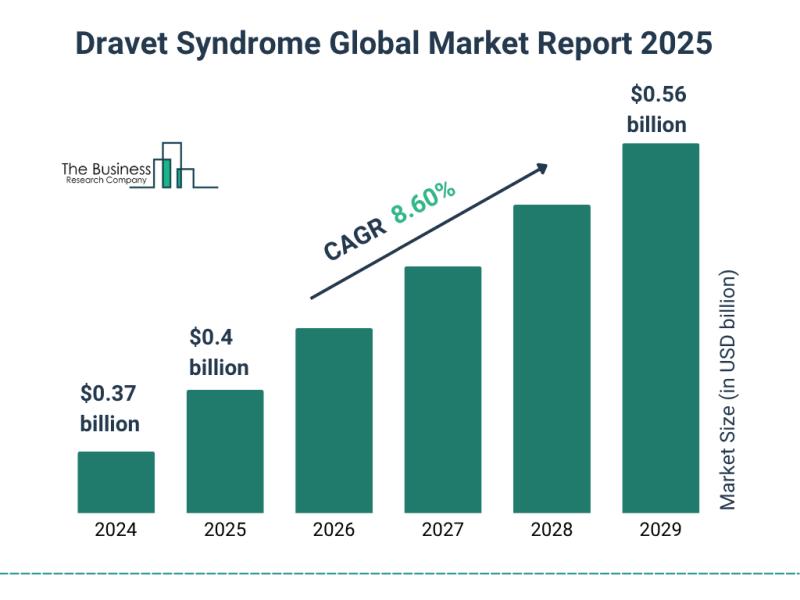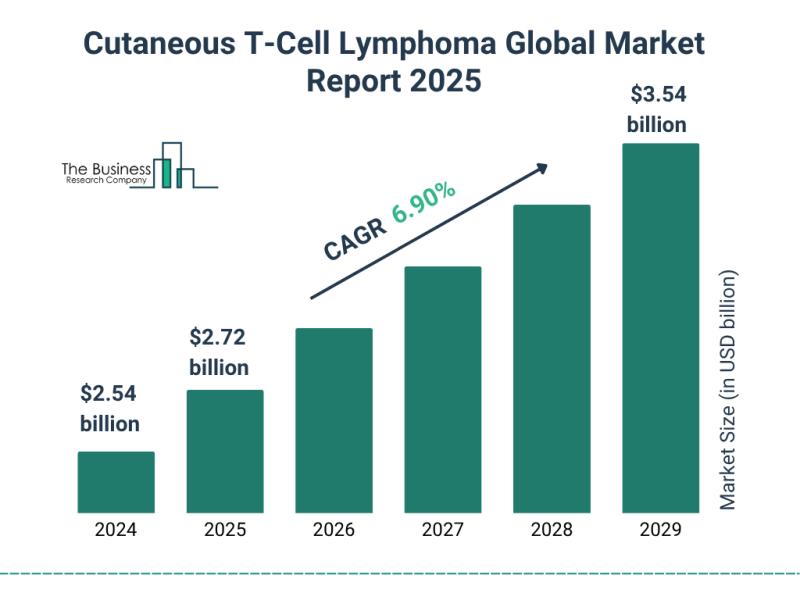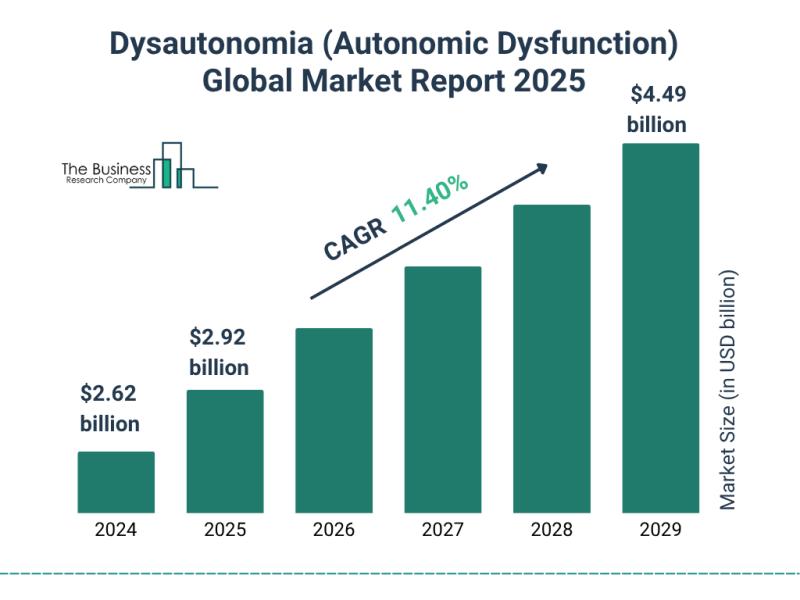Press release
Global Dysautonomia (Autonomic Dysfunction) Market Projected to Grow at 11.4% CAGR, Reaching $4.49 Billion by 2029
Use code ONLINE20 to get 20% off on global market reports and stay ahead of tariff changes, macro trends, and global economic shifts.What Will the Dysautonomia (Autonomic Dysfunction) Industry Market Size Be by 2025?
The global market for dysautonomia, also recognized as autonomic dysfunction, has experienced substantial expansion recently and is projected to increase from its 2024 valuation of $2.62 billion to $2.92 billion by 2025, reflecting a consistent compound annual growth rate of 11.5%; this upward trajectory during the past period is largely a consequence of a higher incidence of conditions affecting the autonomic system, heightened public and medical recognition of dysautonomia, escalating outlays on healthcare services, broader investigative work into neurodegenerative ailments, and augmented governmental backing allocated toward addressing rare diseases.
What's the Long-Term Growth Forecast for the Dysautonomia (Autonomic Dysfunction) Market Size Through 2029?
Anticipation surrounds the dysautonomia market (which encompasses autonomic dysfunction), projecting substantial expansion in the years ahead, with its valuation set to reach $4.49 billion by 2029, reflecting an impressive compound annual growth rate (CAGR) of 11.4%. This upward trajectory through the projected period is bolstered by several key factors: the increasing embrace of individualized medical approaches, a surge in ongoing clinical investigations seeking groundbreaking therapies, heightened governmental financial support directed toward rare disease studies, the broader deployment of telehealth and distanced monitoring systems, alongside a greater supply of medications designated as orphan drugs. Key developments anticipated during this timeframe encompass the incorporation of artificial intelligence technologies within diagnostic processes, the creation of therapies focused on specific targets, the use of wearable gadgets for tracking autonomic functions, progress in genetic treatment modalities, and continuous innovation in treatment strategies centered around patient needs.
View the full report here:
https://www.thebusinessresearchcompany.com/report/dysautonomia-autonomic-dysfunction-global-market-report
What Are the Key Growth Drivers Fueling the Dysautonomia (Autonomic Dysfunction) Market Expansion?
The expanding occurrence of long-term illnesses is anticipated to be the main stimulus for the expansion of the dysautonomia (autonomic dysfunction) market in the near future. A chronic illness is defined as a persistent or enduring health ailment lasting beyond a three-month period. This escalation in chronic conditions is attributed to various elements, notably the heightened incidence of multimorbidity, where individuals concurrently receive diagnoses for several long-term disorders. Dysautonomia (autonomic dysfunction) significantly impacts the management of these chronic diseases because it interferes with the body's mechanisms for controlling vital operations such as blood pressure, cardiac rhythm, and digestive processes, frequently worsening patient symptoms and complicating therapeutic strategies. As an illustration, data released by the National Health Service, a healthcare organization in the United Kingdom, indicated in October 2023 that the incidence of Type 1 diabetes in England saw an uptick, moving from 261,710 instances during the 2020-21 period to 270,935 cases in 2021-22, which represents a year-on-year increase of 3.5%. Consequently, the escalating rates of chronic diseases are directly contributing to the upward trend observed in the dysautonomia (autonomic dysfunction) market.
Get your free sample here:
https://www.thebusinessresearchcompany.com/sample.aspx?id=21177&type=smp
What Are the Key Trends Driving Dysautonomia (Autonomic Dysfunction) Market Growth?
Leading firms within the landscape of dysautonomia (autonomic dysfunction) treatment are concentrating their efforts on progress within gene therapy methodologies, particularly employing recombinant adeno-associated virus vectors as a vehicle to more effectively transport therapeutic genes to requisite cellular targets, with the ultimate goal of boosting patient response across diverse dysautonomia presentations. The modified viral vector known as recombinant adeno-associated virus (rAAV) functions within gene therapy protocols to introduce genetic material into host cells while sidestepping the induction of illness. Illustratively, in January of 2025, the American biotechnology entity Tikun Therapeutics Inc. secured both Orphan Drug and Rare Pediatric Disease Designations from the Food and Drug Administration (FDA) for their gene therapy agent, rAAV2-U1a-hELP1, designed to treat optic neuropathy linked to familial dysautonomia, alongside BPN-36964, a small molecule splicing modulator intended for the comprehensive management of systemic FD; these novel therapeutic approaches are designed to tackle the fundamental genetic underpinnings of FD, suggesting the possibility of protracted advantages beyond methods focused solely on symptom alleviation.
How Is the Dysautonomia (Autonomic Dysfunction) Market Segmented?
The dysautonomia (autonomic dysfunction)market covered in this report is segmented -
1) By Type: Neurogenic Orthostatic Hypotension (NOH); Postural Orthostatic Tachycardia Syndrome (POTS); Multiple System Atrophy (MSA); Pure Autonomic Failure (PAF); Other Types
2) By Tests: Cardiovagal and Vasomotor Function Tests; Thermoregulatory Sweat Test (TST); Sympathetic Skin Response (SSR); Quantitative Sudomotor Axon Reflex Test; Other Tests
3) By Treatment: Physical Therapy; Exercise Therapy; Counseling; Other Treatments
4) By Distribution Channel: Hospital Pharmacy; Online Pharmacy; Retail Pharmacy
5) By End User: Hospitals; Clinics; Diagnostic Centers; Research Institutes
Subsegments:
1) By Neurogenic Orthostatic Hypotension (NOH): Primary NOH; Secondary NOH (due to Parkinson's Disease, Diabetes, etc.); Pharmacological Management of NOH; Non-Pharmacological Interventions
2) By Postural Orthostatic Tachycardia Syndrome (POTS): Hyperadrenergic POTS; Hypovolemic POTS; Neuropathic POTS; Autoimmune POTS; Treatment With Beta-Blockers, Fludrocortisone, And Salt Supplements
3) By Multiple System Atrophy (MSA): MSA-P (Parkinsonism); MSA-C (Cerebellar); MSA-A (Autonomic); Disease-Modifying and Symptomatic Treatment
4) By Pure Autonomic Failure (PAF): Idiopathic PAF; Secondary PAF (due to neurodegenerative diseases); Autonomic Supportive Treatments
5) By Other Types: Familial Dysautonomia (FD); Diabetic Autonomic Neuropathy; Horner's Syndrome; Autoimmune Autonomic Ganglionopathy; Chronic Fatigue Syndrome-related Dysautonomia
Tailor your insights and customize the full report here:
https://www.thebusinessresearchcompany.com/customise?id=21177&type=smp
Which Companies Are Leading the Charge in Dysautonomia (Autonomic Dysfunction) Market Innovation?
Major companies operating in the dysautonomia (autonomic dysfunction) market are Teva Pharmaceutical Industries Ltd., H. Lundbeck A/S, Aurobindo Pharma Limited, Hikma Pharmaceuticals PLC, Cadila Healthcare Limited (Zydus Cadila), Lupin Limited, Nemours Children's Health Delaware, Alnylam Pharmaceuticals Inc., Biohaven Pharmaceuticals Holding Company Ltd., Aurora Health Care Inc., Camber Pharmaceuticals Inc., Theravance Biopharma Inc., Tocris Bioscience, Celltex Therapeutics Corporation, DyAnsys Inc., Axplora Inc., MODAG GmbH, Inhibikase Therapeutics Inc., Mylan Pharmaceuticals Private Limited, Chelsea Therapeutics International Ltd.
Which Regions Are Leading the Global Dysautonomia (Autonomic Dysfunction) Market in Revenue?
North America was the largest region in the dysautonomia (autonomic dysfunction) market in 2024. Asia-Pacific is expected to be the fastest-growing region in the forecast period. The regions covered in the dysautonomia (autonomic dysfunction) market report are Asia-Pacific, Western Europe, Eastern Europe, North America, South America, Middle East, Africa.
Purchase the full report today:
https://www.thebusinessresearchcompany.com/purchaseoptions.aspx?id=21177
This Report Supports:
1.Business Leaders & Investors - To identify growth opportunities, assess risks, and guide strategic decisions.
2.Manufacturers & Suppliers - To understand market trends, customer demand, and competitive positioning.
3.Policy Makers & Regulators - To track industry developments and align regulatory frameworks.
4.Consultants & Analysts - To support market entry, expansion strategies, and client advisory work.
Reach out to us:
The Business Research Company: https://www.thebusinessresearchcompany.com/,
Americas +1 310-496-7795,
Europe +44 7882 955267,
Asia & Others +44 7882 955267 & +91 8897263534,
Email us at info@tbrc.info.
Follow Us On:
LinkedIn: https://in.linkedin.com/company/the-business-research-company,
Twitter: https://twitter.com/tbrc_info,
YouTube: https://www.youtube.com/channel/UC24_fI0rV8cR5DxlCpgmyFQ
Learn More About The Business Research Company
With over 17500+ reports from 27 industries covering 60+ geographies, The Business Research Company has built a reputation for offering comprehensive, data-rich research and insights. Armed with 1,500,000 datasets, the optimistic contribution of in-depth secondary research, and unique insights from industry leaders, you can get the information you need to stay ahead.Our flagship product, the Global Market Model (GMM), is a premier market intelligence platform delivering comprehensive and updated forecasts to support informed decision-making.
This release was published on openPR.
Permanent link to this press release:
Copy
Please set a link in the press area of your homepage to this press release on openPR. openPR disclaims liability for any content contained in this release.
You can edit or delete your press release Global Dysautonomia (Autonomic Dysfunction) Market Projected to Grow at 11.4% CAGR, Reaching $4.49 Billion by 2029 here
News-ID: 4279400 • Views: …
More Releases from The Business Research Company

Key Factor Supporting Global Dravet Syndrome Market Development in 2025: Impact …
Use code ONLINE20 to get 20% off on global market reports and stay ahead of tariff changes, macro trends, and global economic shifts.
How Large Will the Dravet Syndrome Market Size By 2025?
The market valuation for Dravet syndrome has demonstrated a robust expansion recently, projected to ascend from $0.37 billion in 2024 to $0.4 billion the following year, realizing an 8.7% compound annual growth rate. This upward trajectory throughout the historical…

Rising Cancer Prevalence Fueling Growth In The Market: A Key Catalyst Accelerati …
Use code ONLINE20 to get 20% off on global market reports and stay ahead of tariff changes, macro trends, and global economic shifts.
Febrile Neutropenia Market Size Valuation Forecast: What Will the Market Be Worth by 2025?
The market encompassing febrile neutropenia has experienced robust expansion across recent years, projected to advance from a valuation of $10.6 billion by 2024 to $11.28 billion come 2025, reflecting a compound annual growth rate of…

Comprehensive Cutaneous T-Cell Lymphoma Market Forecast 2025-2034: Growth Trends …
Use code ONLINE20 to get 20% off on global market reports and stay ahead of tariff changes, macro trends, and global economic shifts.
Cutaneous T-Cell Lymphoma Market Size Valuation Forecast: What Will the Market Be Worth by 2025?
The overall valuation of the cutaneous t-cell lymphoma sector has experienced a robust uptrend lately, projected to advance from $2.54 billion in the year 2024 to reach $2.72 billion by 2025, reflecting a compound…

Rising Blood Disorders Drive Growth In The Market: Transformative Forces Shaping …
Use code ONLINE20 to get 20% off on global market reports and stay ahead of tariff changes, macro trends, and global economic shifts.
What Will the Coagulation Factor Deficiency Industry Market Size Be by 2025?
The market catering to coagulation factor deficiencies has experienced robust expansion lately, projected to ascend from its 2024 valuation of $4.58 billion to $4.93 billion in 2025, marking a compound annual growth rate of 7.7%. Factors driving…
More Releases for Autonomic
Cardiac Autonomic Control Market Grows Amid Advancements in Remote Monitoring an …
InsightAce Analytic Pvt. Ltd. announces the release of a market assessment report on the "Global Cardiac Autonomic Control Market- (By Product Type (Implantable Cardiac Autonomic Control Devices, External Cardiac Autonomic Control Devices), By Application (Heart Rate Control, Blood Pressure Control, Arrhythmia Control, Others), By End-User (Hospitals and Clinics, Ambulatory Surgical Centers, Research Institutes, Others)), Trends, Industry Competition Analysis, Revenue and Forecast To 2031."
According to the latest research by InsightAce Analytic,…
Cardiac Autonomic Control Market Regulating the Rhythm: Addressing Cardiovascula …
Cardiac Autonomic Control Market worth $29.31 Mn by 2031 - Exclusive Report by InsightAce Analytic Pvt. Ltd.
InsightAce Analytic Pvt. Ltd. announces the release of a market assessment report on the "Global Cardiac Autonomic Control Market- (By Product Type (Implantable Cardiac Autonomic Control Devices, External Cardiac Autonomic Control Devices), By Application (Heart Rate Control, Blood Pressure Control, Arrhythmia Control, Others), By End-User (Hospitals and Clinics, Ambulatory Surgical Centers, Research Institutes, Others)),…
Autonomic Networks Announces Merger with Zoologico Santa Fe
Autonomic Networks, a leading provider of innovative networking solutions, is pleased to announce its merger with Zoologico Santa Fe Business Solutions, the esteemed business arm of Zoologico Santa Fe. This strategic merger brings together Autonomic Networks' expertise in network automation and Zoologico Santa Fe Business Solutions' commitment to sustainability and environmental stewardship, creating new opportunities for innovation and growth in the technology and conservation sectors.
Autonomic Networks has established itself as…
Cardiac Autonomic Control Market Research Report 2023 | InsightAce Analytic
InsightAce Analytic Pvt. Ltd. announces the release of a market assessment report on the "Global Cardiac Autonomic Control Market- (By Product Type (Implantable Cardiac Autonomic Control Devices, External Cardiac Autonomic Control Devices), By Application (Heart Rate Control, Blood Pressure Control, Arrhythmia Control, Others), By End-User (Hospitals and Clinics, Ambulatory Surgical Centers, Research Institutes, Others)), Trends, Industry Competition Analysis, Revenue and Forecast To 2031."
According to the latest research by InsightAce Analytic,…
Electronic Aspirin Market Future Innovation Strategies 2025 | Autonomic Technolo …
Global Electronic Aspirin Market: Overview – Paralyzing headaches have become common in several parts of the world. Often related to stress, genetics, and lifestyle choices, these headaches are known to impair normal functions for patients. Known as cluster headaches, which can be mistaken as a symptom for several other incidents, they are felt in and around one eye. Also referred to as migraines, these headaches can lead to swelling, nasal…
Electronic Aspirin Market forecast 2025 | Currently, Autonomic Technologies, Inc
Global Electronic Aspirin Market: Overview
Paralyzing headaches have become common in several parts of the world. Often related to stress, genetics, and lifestyle choices, these headaches are known to impair normal functions for patients. Known as cluster headaches, which can be mistaken as a symptom for several other incidents, they are felt in and around one eye. Also referred to as migraines, these headaches can lead to swelling, nasal congestion, and…
